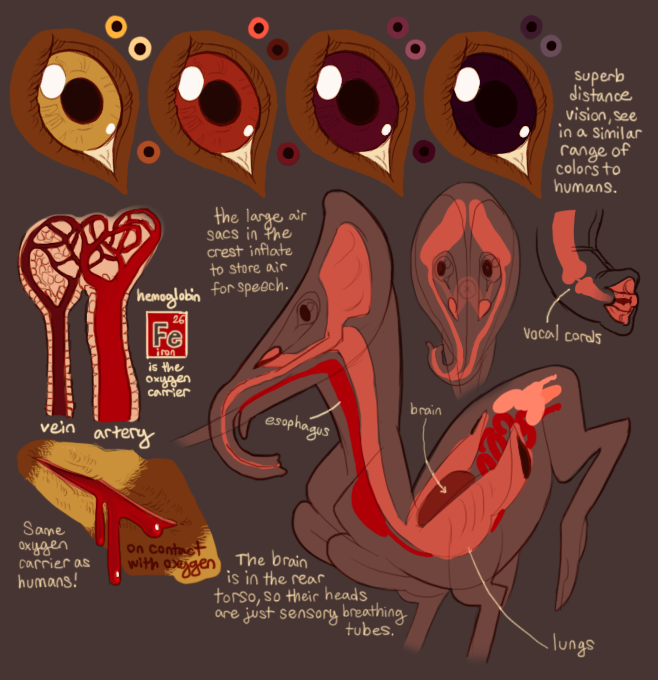Centaurs' evolutionary ancestors were savanna pack predators who used ambush to hunt prey, nomadically following prey animal herds as they traveled round the global continent every year. Modern centaurs emerged when they started to use tools to help with hunting and land management, eventually resulting in some groups settling down and becoming reliant on fishing, animal agriculture, and food preservation to survive. Centaurs remain obligate hypercarnivores, meaning approximately 70% of a healthy diet is meat and animal products, but they opportunistically supplement their diet with grain, starchy tubers, and small amounts of roughage and vegetation.
Similar to humans, centaurs have a bisex reproductive system with an inseminator sex and gestator sex who gave birth to live young, but functionally are more similar to Earth's marsupials. Centaur’s distant ancestors had larvae that lived in the soil like grubs before pupating into adults, and their "mammalian" silk eating clade first emerged after parental care of the larval stage evolved. While other members of their clade have development and pupation both happen in-utero, centaur litters leave the womb early and feed on their parent’s nutritive silk until they are large enough to pupate, spinning a cocoon on their parent’s back.
Centaurs also are proto-eusocial, and organize into clan structures with a matriarch, their entourage, and "workers." These non-reproductive clan members are generally either the matriarch's children, childless relatives, and individuals “married in” for their skills or political purposes.
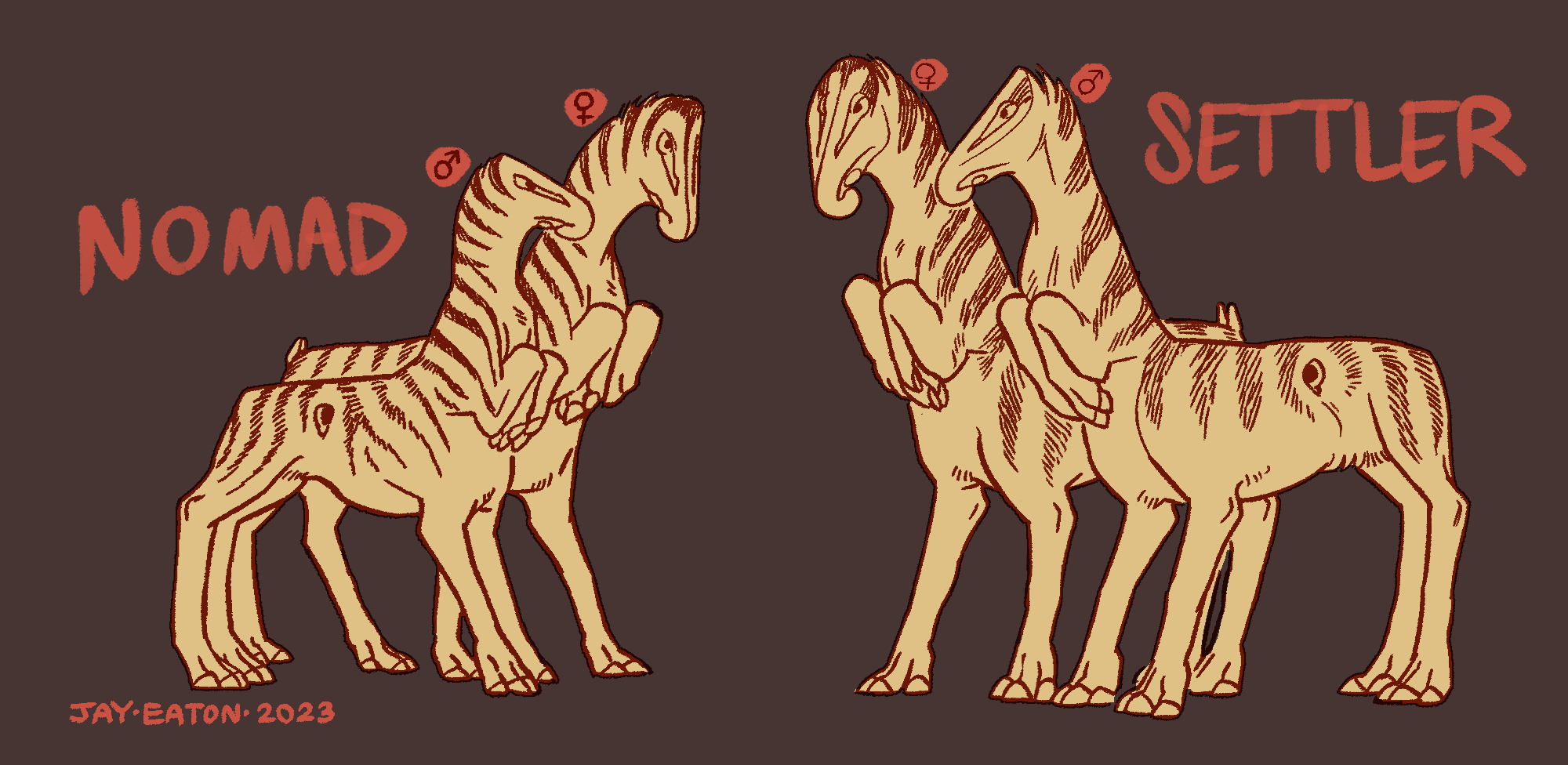
Centaurs have many ethnicities, but there are two major groups divided by lifestyle. Although they have many notable differences in physiology, they are not considered separate species as geneflow between the two groups is fairly high.
Nomads tend to be smaller, stockier, with shorter spines and higher endurance. They have a more “canine” lifestyle, walking long distances driving and livestock and wild stock prey herds as they go. In bare-handed hunting they tend to favor organized sprinting pursuit, similar to wolf prey capture.
Settler centaurs tend to be larger, with longer, more flexible spines and higher sprint speeds. They have a more “feline” lifestyle, with clans occupying fixed territories of livestock and wild prey. In bare-handed hunting they tend to favor stalking followed by short sprints, like cheetah or lion prey capture.
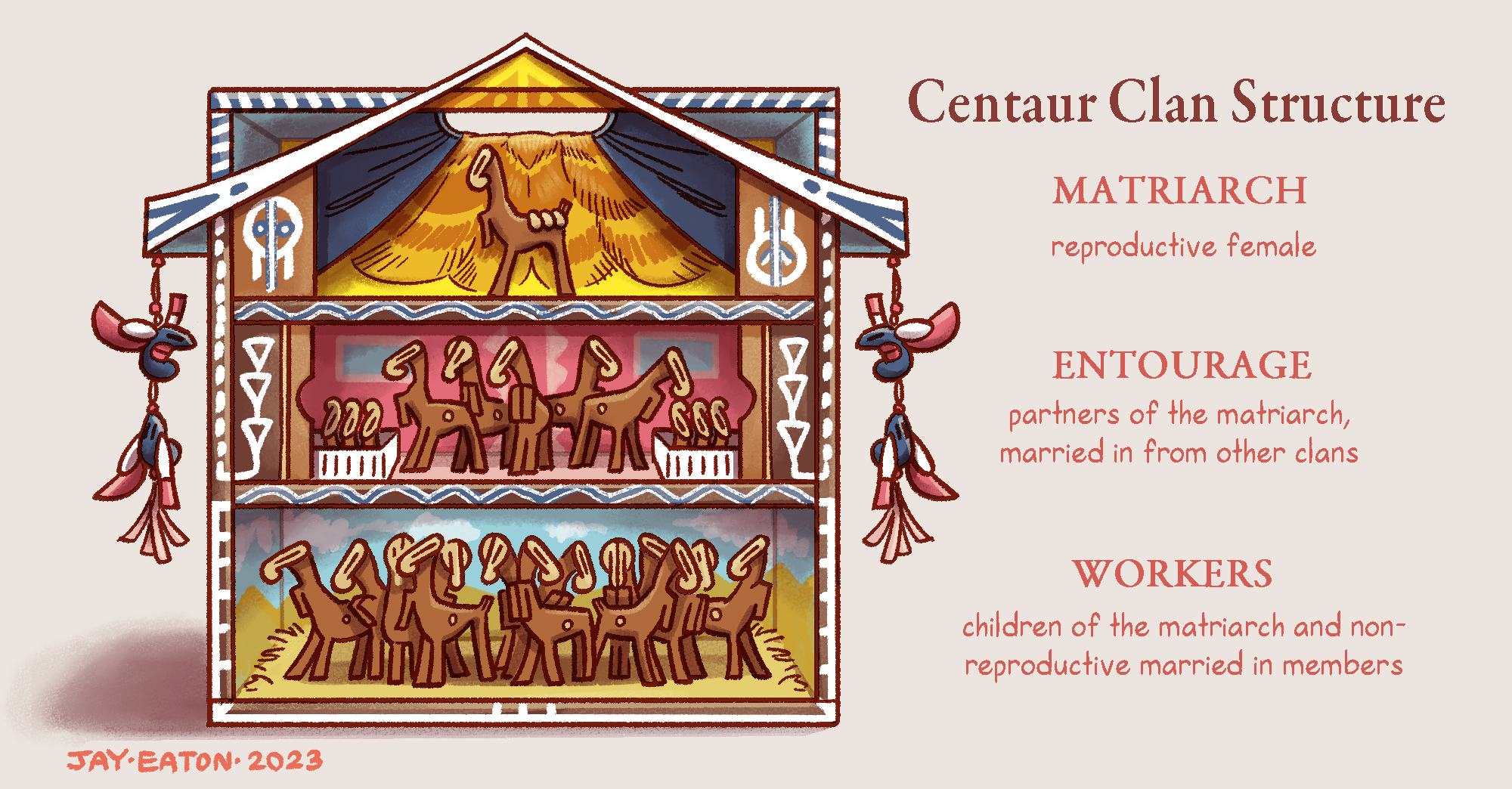
Centaurs are pseudo-eusocial, with a social structure hierarchy somewhat similar to meerkats. At its most basic level a clan consists of one matriarch, a female who is responsible for bearing the clan's young; the entourage, who are the matriarch's partners and usually mostly male; and the clan's workers, who are not involved in reproduction. Females are larger and stronger than males on average, and worker females are usually involved more in labor tasks and males more in childrearing. Centaur males are more likely to have a visual "cute" reaction to infants and animals than females. There are no major physical differences in centaurs with different clan roles.
Female centaurs have a very slow estrus cycle by default, and are only actually capable of becoming pregnant about once a year. Getting pregnant routinely speeds that cycle up to several times a year. More detail on the reproduction page. Other centaurs can usually determine estrus (and thus matriarch status) by scent. Although partnerships between workers are fairly common, in more conservative clans sex may only be permitted between homosexual couples, or outright celibacy is enforced.
Centaurs who regularly experience pregnancy experience innate aggression towards infants they didn't birth. Matriarchs will usually respond to other members of the clan becoming pregnant by either ousting them to form their own clan, or infanticide. Nomads have especially strong infant-aggression and a propensity to smaller clans, while centaurs in urban centers tend to have lower infant-aggression. Some urban centers even have multi-matriarch clans with a shared worker and entourage pool, though the different matriarch's litters are usually raised in separate buildings to prevent irritation.
Centaurs sleep cycles vary a lot depending on ethnicity and where on the homeplanet they live. Nomads (like Talita) are primarily diurnal and settled centaurs lean towards crepuscular, sleeping for 4-5 hour periods at midday and midnight. Settlers in far north or south regions may enter a hibernation state during midwinter, sleeping for 2-3 day periods and waking to stretch and take care of body function business. Midsummer in the far north and south changes their crepuscular sleeping habit to nocturnal, though the sun doesn’t set so much as lower in the sky. On average they sleep about 12 hours for every 24, Talita is usually sleep deprived because she’s like a lion trying to keep a human schedule.
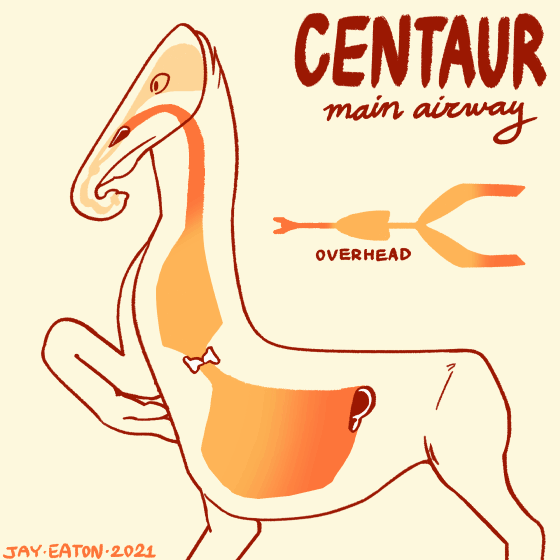
The main airway is unidirectional, except for the occasional sneeze. Air enters through the incurrent nostrils on the face, passes into the first air chamber, then to the main lungs that surround the heart and braincase, and then exits out the excurrent nostrils/vents on the rear of the lower ribcage. The majority of oxygen exchange and moisture reclamation happens in the lower lungs, which have a gill-like, high surface area comb structure that the air passes through. Centaurs cool themselves mostly by panting, where they breathe rapidly and open the lung structure up wider in the chest to allow more air to bypass the comb and leave with water and waste heat. They can produce subsonic hums, rattles, and groans out the excurrent nostril by clenching the valve.
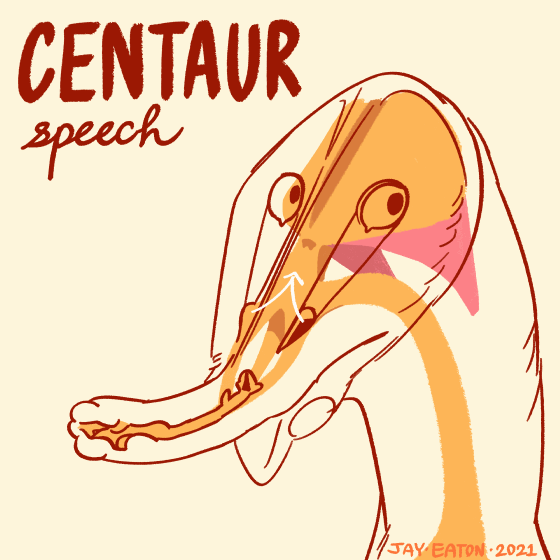
The centaur vocal apparatus evolved from an olfactory structure that got co-opted for language. There are still scent receptors in it, but the thing has become much more elaborate than in their ancestors. To speak, they breathe into two large sinuses on the back of their head, close those off from the main airway, and compress them to push air out through the trunk. Of the aliens in Runaway to the Stars, centaurs are probably the best at vocalizing human languages. The phonic structure is pretty similar to ours, consisting of vocal cords set in the skull at the base of the trunk, resonant loops back to the incurrent nostrils, and muscular ridges inside the trunk towards the lips. Their large toothed mouth is totally unconnected to the respiratory system, it only leads into the esophagus.
Centaurs have a large four-chambered heart in their rear torso and an auxillary two-chambered heart in their foretorso. They use a red iron-based oxygen carrier molecule, similar to humans, but have more translucent blood with a lower density of the pigment because their respiratory system is more efficient at oxygen collection than a human's.
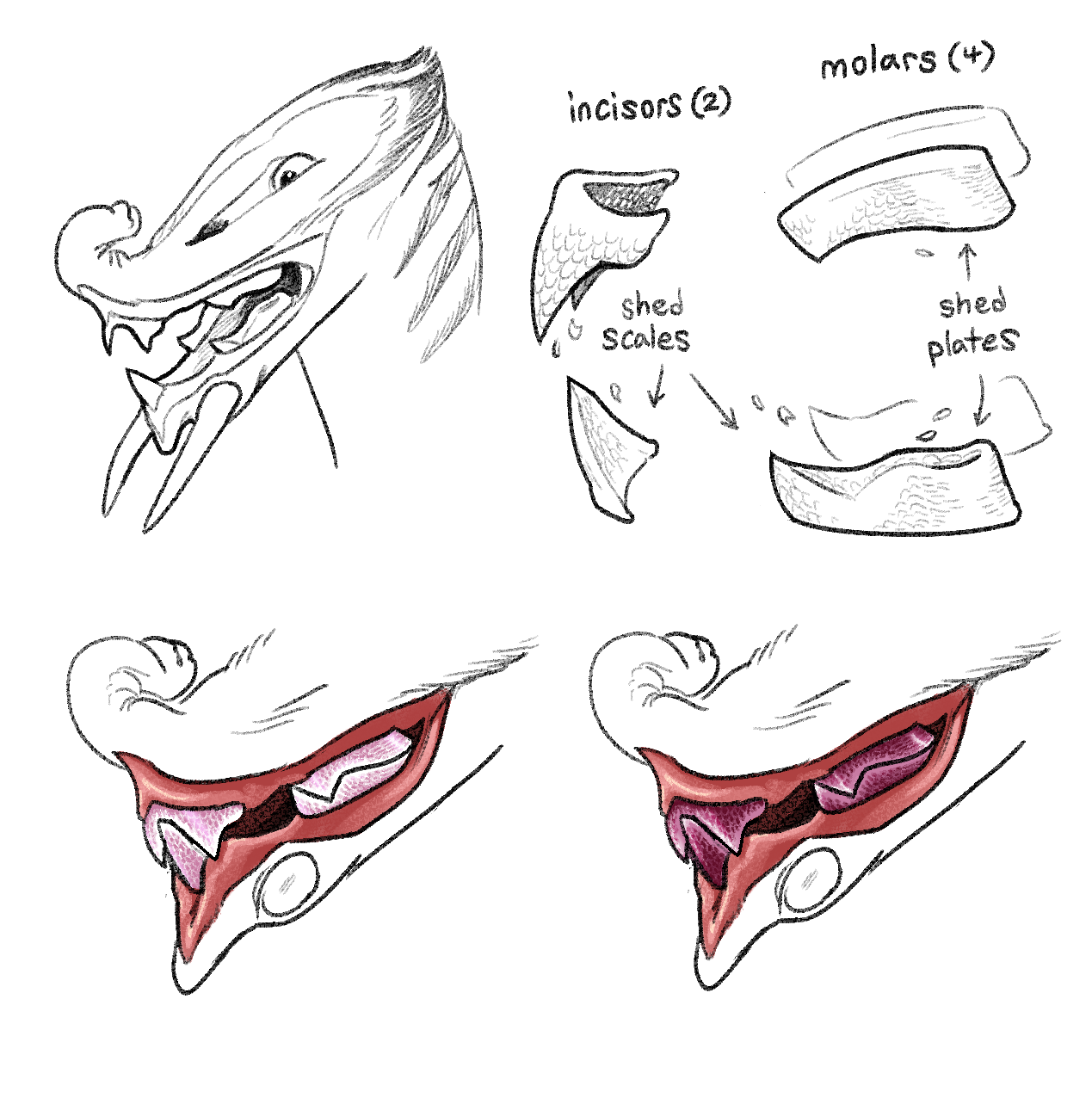
Centaurs have six teeth that continuously grow from the root and shed scales/plates from use. This serves as a self sharpening and cleaning mechanism. The front two teeth form an incisor beak for hooking prey or cutting food, and the rear four function like molars or carnassial teeth, useful for grinding food and crushing bone. Their teeth can be pigmented anywhere from light pink to dark purple, which varies based on local genetics. Centaur's guts are relatively short and not capable of digesting a lot of plant matter. They have a crop in their foretorso and a digestive stomach in their rear torso.
Centaurs have their primary brain in their mid torso and a much smaller secondary brain in their head. The primary brain handles higher cognitive function, while the secondary brain deals with immediate sensory processing and fight-or-flight reactions. Also, unlike us, their nervous cord runs underneath the mass of the spine. This is much safer and more reasonable than its placement on humans; our nervous cord runs along the outer side of the spine. Their first pair of limbs are attached to a single large girdle bone, like if you had a pelvis in your neck.
The centaur setup with the cognition-focused midbrain sitting in the midsection and a fight-or-flight/sensory ganglion at the very front end also means they are more prone to various nervous degeneration issues in their old age. Diseases like MS are bad enough for humans with our main senses right next our brain, in centaurs the resulting communication delays down the spine can cause some pretty debilitating behavioral and sensory conditions.
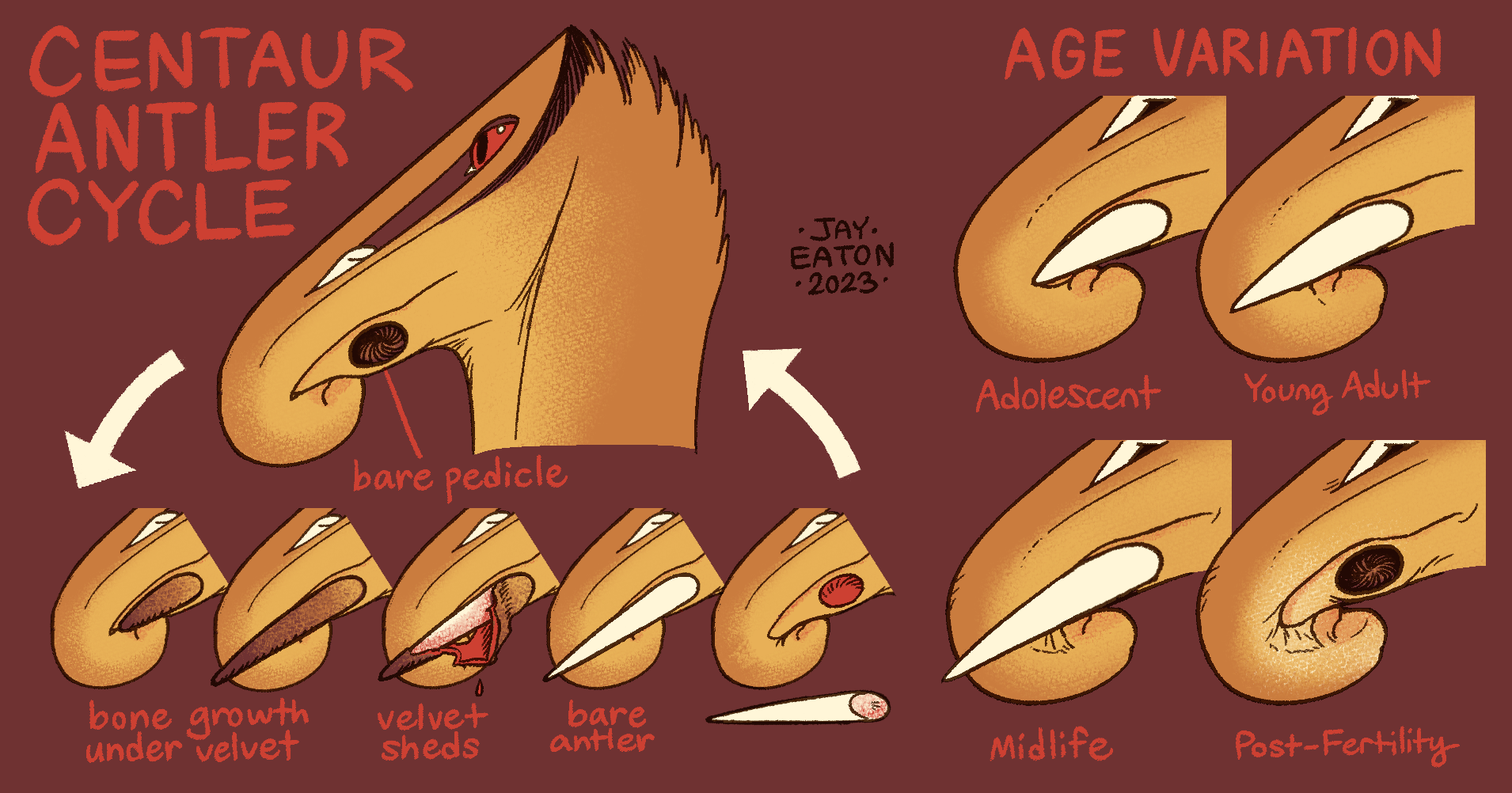
Although they resemble the tusks of some Earth animals, the bony protrusions from the lower jaw of adult centaurs are actually antlers. They are seasonal structures that grow in once a year under velvet, which then bloodily sheds off to reveal bare bone. At the end of the season, they fall off and leave only the dark pedicle scar on the lower jaw.
Antlers grow in both sexes and although they can be used as weapons, their purpose is more of a social signifier. Centaurs first begin growing them during puberty, and they get slightly longer with each regrowth until menopause/old age. Matriarchs classically retire from their position in a clan after their antlers stop growing in. A centaur in particularly bad health may have stunted antler growth during the usual growth period.
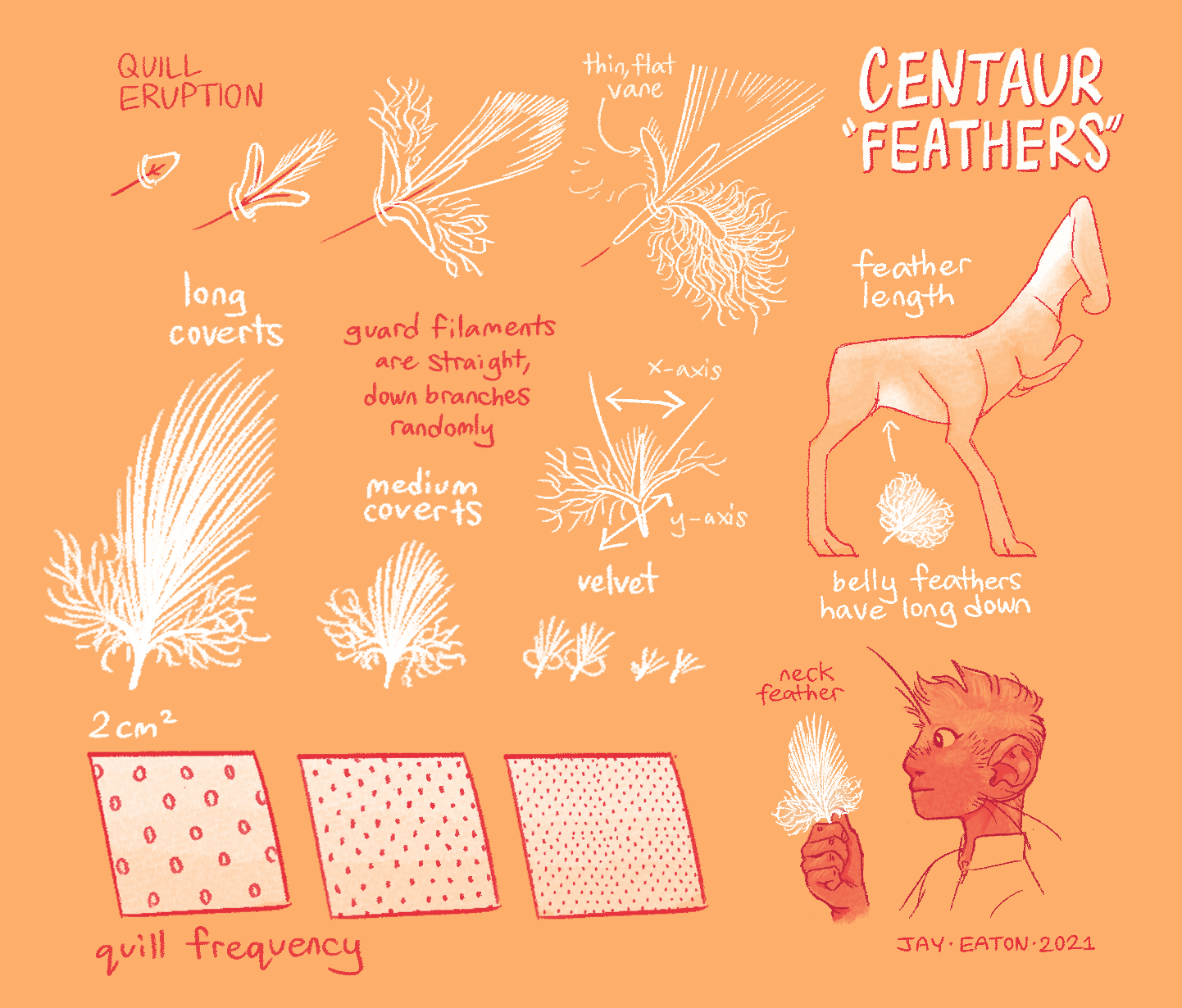
Centaur integument is comparable to feathers, but they are not that similar on a structural or developmental level. The surface feeling of their velvet would be similar to horse fur, and their long coverts more like big cat fur– but if you dug your fingers in you would feel the densely packed, thin quill bases and bird-like down. They shed continuously and have oil glands at the bases of their quills sort of like Earth mammals do.
With huge eyes and a tapetum lucidum to reflex light back into the retina, centaurs have phenominal day and night vision. The high resolution of their retinas gives them fantastic distance vision, often able to track individual figures moving over 10km away. Their close range vision, however, is not great and for the average centaur objects closer than a meter become unfocused. Many modern centaurs use eye lenses to assist in detail work, but historically centaurs would use their trunk to feel and manipulate small objects in close range, particularly for applications like sewing.
Centaurs also have a cognitive bias towards motion tracking, and while they can easily track most rapidly and irregularly moving objects, they have often have difficulty processing dense patterns. Spotting texture and color variations in vegetation is difficult for them, and this difficult may contribute to higher difficulty in reading dense blocks of text typical of other sophont's writing systems.
Centaurs have acute hearing over a wide range of pitch, including the infrasonic noises that adult centaurs produce with their excurrent nostrils for emotional expression.

